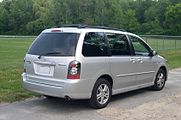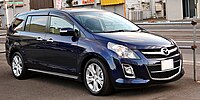Mazda MPV
| Mazda MPV | |
|---|---|
| Production period: | 1988-2016 |
| Class : | Van |
| Body versions : | Station wagon |
| Successor: | Mazda5 |
The Mazda MPV is a passenger car model from the Japanese car manufacturer Mazda , which has been in production since autumn 1988.
From autumn 1994 the vehicle was also imported to Europe and the USA, but was taken off the market in summer 2005 due to steadily falling sales.
In 2016 Mazda stopped production of the van.
MPV (1988–1999)
| 1st generation | |
|---|---|
|
Mazda MPV (1988-1994) |
|
| Production period: | 1988-1999 |
| Body versions : | Station wagon |
| Engines: |
Otto engines : 3.0 liters (109–113 kW) Diesel engines : 2.5 liters (85 kW) |
| Length: | 4470-4670 mm |
| Width: | 1825 mm |
| Height: | 1694-1750 mm |
| Wheelbase : | 2805 mm |
| Empty weight : | 1710-1830 kg |
The first generation of the MPV (abbreviation for " M ulti P urpose V ehicle") came on the Japanese and North American markets at the end of 1988.
The MPV was a large-capacity limousine that was equipped with seven seats and initially four doors (three on the sides including a sliding door on the right and the wide-opening tailgate). Initially, the only engine available was a 3.0-liter petrol engine with 113 kW (154 hp), which was based on a 60 ° six-cylinder unit from the 1960s and already powered the Ford Capri and Granada .
The V6 engine built into the front powered the MPV on the rear wheels or (only in the USA) optionally on all four wheels and accelerated the van from zero to 100 km / h in 12.6 seconds. The maximum speed of the vehicle was 170 km / h.
The car was only delivered with a four-speed automatic transmission, which, with its angular shape and an unladen weight of around 1.8 tons, resulted in an average consumption of up to 13.9 liters / 100 km.
Facelift
With a subtle facelift in October 1994 (different Mazda logo on the front and rear), the MPV was now also offered on the European markets. Technically, nothing in the concept had changed.
In March 1996, Mazda made a more profound facelift on the MPV. The outer length increased by 20 centimeters to 4.67 m.
The most important innovation, however, was another door for the rear seats on the driver's side. In addition, another engine was added to the range with the 85 kW (115 PS) 2.5 l turbo diesel. Its consumption averaged 9.3 l / 100 km.
The V6 petrol engine has also been modernized. Due to stricter emission standards, it only produced 109 kW (148 hp), but was around 100 kg lighter and could therefore also reach a higher top speed of 185 km / h. This was mainly due to the manual five-speed gearbox, which replaced the antiquated automatic transmission.
With the CS , a second equipment line was offered, which had two single seats in the second row, rear heating, air conditioning and light alloy wheels. The basic version now also contained the driver and front passenger airbags as well as ABS as standard.
In Japan, the model was associated with a higher quality equipment in the model range of the brand efini to find.
MPV (1999-2005)
| 2nd generation | |
|---|---|
|
Mazda MPV (1999-2002) |
|
| Production period: | 1999-2005 |
| Body versions : | Station wagon |
| Engines: |
Otto engines : 2.0–2.3 liters (90–104 kW) Diesel engine : 2.0 liters (100 kW) |
| Length: | 4750-4813 mm |
| Width: | 1831 mm |
| Height: | 1750-1785 mm |
| Wheelbase : | 2840 mm |
| Empty weight : | 1610-1780 kg |
After eleven years of construction, the second generation of the MPV was presented in November 1999.
It grew to a total length of 4.75 m, with the width and height hardly changing compared to the first generation, which was revised from spring 1996. At the beginning, however, there were only five seats available. From the outset, however, it had two sliding doors to facilitate entry for the rear passengers.
Initially, the vehicle was sold with just one four-cylinder gasoline engine from the Mazda 626 , which had a displacement of two liters and developed 90 kW (122 hp). Its top speed was 178 km / h.
There were two equipment lines to choose from:
- Comfort (standard: ABS, driver / front passenger airbag, electrically adjustable and heated exterior mirrors, tinted glazing, air conditioning, central locking, electric window lifters, three individual seats at the rear and velor upholstery)
- Exclusive (additionally: fog lights, outside temperature display, light alloy wheels, colored side protection strips, additional heating at the rear, central locking with remote control, leather steering wheel and wood decor)
Facelift
In May 2002 a visually and technically modified MPV appeared on the market.
The front now received the five-point radiator grille used on many models. The rear could be recognized by the slightly different lights. The chassis and interior have also been revised and the safety of the occupants has been upgraded with two additional airbags at the rear.
Roof rails were now also on board as standard, as was a leather steering wheel for the Exclusive equipment line .
There was also a lot going on under the bonnet: the drive was now either a 2.3 l MZR petrol engine with 104 kW (141 hp) or a 2.0 l MZR CD diesel engine with 100 kW (136 hp) ) because the 2.0-l four-cylinder lacked draft, which was due to the weight of the MPV.
In March 2003, a seven-seater variant was added to the program again.
In November 2003 the MPV was given another small facelift, which could be seen in the headlights with clear glass optics, smooth bumpers and again modified rear lights. New LM wheels in 16 "format and exterior and interior chrome applications were further features of this facelift.
In addition, there were now ventilated disc brakes at the rear. A program for vehicle stability (TCS) was also used.
In June 2004, the seven-seater was removed from the list of offers.
Production of the second generation of MPVs ended in July 2005.
MPV (2005-2016)
The third generation of the MPV was presented at the Tokyo Motor Show in Japan in autumn 2005. In Germany and the USA, however, the sale of the vehicle was thus ended and replaced by the smaller Mazda5 . The third generation MPV is offered in Japan, China and Hong Kong, Macau, Indonesia, Thailand and Malaysia. In Hong Kong, Indonesia, Macau and Malaysia it is marketed as Mazda8.
literature
- Joachim Kuch, Mazda since 1920 , Motorbuch Verlag, 2009, pp. 210–213 u. 254 (technical data). ISBN 978-3-613-03028-2 .











